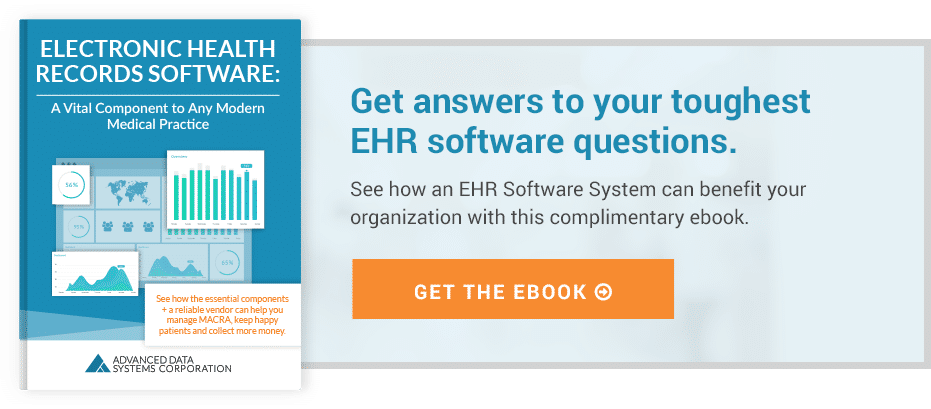A Complete Overview of Orthopedic Software
When you run an orthopedic practice, your staff will have different processes and needs to address as compared to other specialties as well as family doctors. For example, you likely will have more referral patients, coming from emergency rooms, pain clinics, and general doctors, with the need to share information with these various entities to keep them updated on the progress of the patients.
Orthopedic professionals typically must deal with a large amount of lab test results, especially when it comes to imaging during diagnosis and for follow-ups as you chart the progress of the patient during recovery.
If your orthopedic practice is trying to keep things running smoothly by still relying on an antiquated system based on paper records for the most part, you should know that software options are now available to help you run the office much more efficiently.
In particular, you’ll need to become acquainted with electronic health record software, practice management software, and an all-in-one combination of EHR and PM software that you can access safely and securely from the cloud using an ordinary web browser.
Get answers to your toughest EHR software questions. See how an EHR Software System can benefit your orthopedic practice with our complimentary ebook.
Understanding Electronic Health Records Software
You’ve undoubtedly heard that medical practices are increasingly turning to the use of electronic health records or EHR software and may even have colleagues working in different offices where this software's use has been established for some time now. A cursory glance at the chief benefits and features of EMR applications will underscore the risk of not adopting it yourself, lest you fall behind the competition.
Features and Benefits of Electronic Health Records Systems
EHR software is basically a computerized form of your patients’ charts, which you update during each encounter with a doctor, nurse, or nurse practitioner. The main benefits and features of an EHR include:
- Security: In keeping with the requirements of the Health Insurance Portability and Accountability Act or HIPAA, medical organizations including orthopedics practices must safeguard the information that they collect and create for each patient. Your EHR application will include robust encryption and other security protocols to keep this sensitive information away from criminal intruders bent on identity theft and fraud.
- Device Convenience: Your staff can use standard desktop computers and laptops in the office, as well as access patient information and make updates to it via tablet, computers, and smartphones.
- Transcription: The speech recognition capability that you can enable in your EHR lets your nurses and doctors simply speak to see their words automatically transformed into digital text on the screen in patient records. You don’t have to send recordings out to a professional transcription service anymore.
- Patient Portal: The patient portal feature of the EHR provides a great deal of convenience. Patients can fill out their intake forms electronically, only needing to provide information such as their next of kin one time only instead of repeatedly entering details on multiple sheets of paper. They can enter their information using a home computer or a computer in your waiting area, and your staff won’t have to spend time transcribing paper documents.
- Reporting: The reports that your team must generate (such as weekly outstanding payments) are easier to generate with an EHR, which lets you set up customized documents to output on a regular basis.
- e-Prescribing: Allowing your physicians to prescribe medications electronically saves time for staff and patients alike, and using e-prescriptions sets you up for financial incentives from Medicare and Medicaid.
What Is Practice Management Software?
How do you keep track of what’s happening in your office and manage all the processes of your practice? The answer is Practice Management software.
Features of Practice Management Software
Practice management software gives your staff a number of timesaving tools that free you up to allocate more resources to taking care of and engaging with patients.
Use a PM application to take care of checking on a patient’s insurance status online instead of waiting on hold to speak with someone at the insurance company.
Practice management software makes it easier to set appointments, and in a busy orthopedic practice, you’ll appreciate how much more convenient it will be to set up all the recurring follow-up appointments to check the progress of each patient.
What’s more, PM software streamlines the work you must do to manage denied claims. Management will find it enormously helpful when it comes time to generate regular staff reports.
About Browser-based EHR and PM Software
How many employees do you currently have on staff? Do you know how many individuals will be working for you next year? The difficulties that can come when trying to predict your work requirements and staffing numbers means it can be hard for your IT department to figure out how much to budget for server space as well as software licensing.
But when you adopt an all-in-one cloud computing approach, you will save money and effort, because employees can simply access the EHR and PM software tools from their web browser. They can do this from any location via the Internet, and the orthopedic software will work just as it would if was hosted on your local servers.
The cloud computing partner will have its own IT staff that is taking care of hardware requirements for expansion. This means that instead of you figuring out how much server space to add, the cloud computing professionals will monitor and take care of this for you. Your staff can then be freed up for non-cloud-computing technical matters.
Orthopedics-oriented EHR and PM software in the cloud will alert your doctors automatically whenever they are seeing a patient who is eligible for a new clinical trial. You can use the software to conduct sophisticated data mining analysis to further identify promising patients for such trials.
The software allows practices to qualify for CMS programs, making them eligible for financial incentives, such as by attesting to Stage 2 Meaningful Use.
Managing a thriving orthopedic practice can be quite a complicated affair, especially if you are hampered by your staff having to rely on an old-fashioned, paper-based system. Clearly, the use of electronic health record software and practice management software, especially in a cloud computing setup, will help to increase your efficiency and improve your vital processes.
Key Takeaway:
- Electronic health record or EHR software has been finding increasing use in medical practices during the past few years.
- Practice management or PM software is designed to help you keep your practice well organized and humming along and works much better than a paper-based system.
- Orthopedic practices stand to benefit from using EHR and PM software because of the efficiencies it brings.
- An example of benefits to patients by using EHR and PM software is the patient portal that you let them use to submit their information electronically and stay in touch with staff.
- Many orthopedic specialists find it beneficial to use an all-in-one, combined EHR and PM setup that is accessible to staff from anywhere via cloud computing.
- Make sure that you go with an orthopedic software provider that has a proven track record in maintaining and updating its medical applications on a regular basis.
To help you smooth the way during your transition to EHR and PM software, click here to download a copy of our e-book, “Electronic Health Records Software: A Vital Component to Any Medical Practice.”
About Stephen O'Connor
Stephen O'Connor is the Director of Brand and Digital Marketing, responsible for many aspects of Advanced Data Systems Corporation’s (ADS) marketing, including product marketing, customer acquisition, demand generation, brand, brand design, and content marketing.
Stephen has more than 20 years of healthcare industry experience. Prior to ADS, Stephen spent 11 years at Medical Resources Inc. (MRI), most recently as the Manager of Marketing & Internet Services, where he and his teams were responsible for all marketing efforts and the market positioning of MRI’s services.
Stephen spends his day's planning, writing, & designing resources for the modern healthcare professional.








